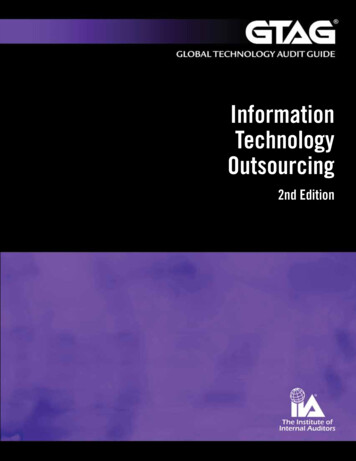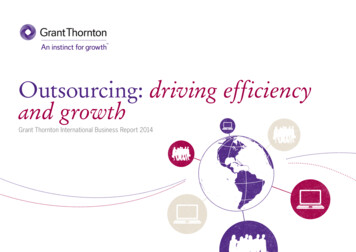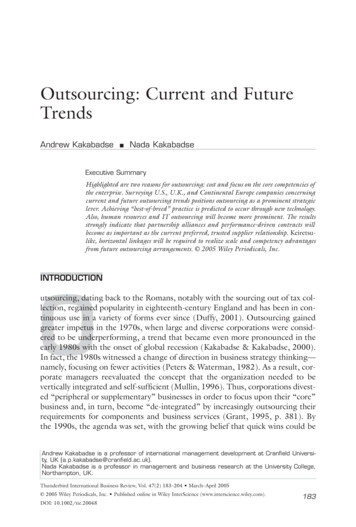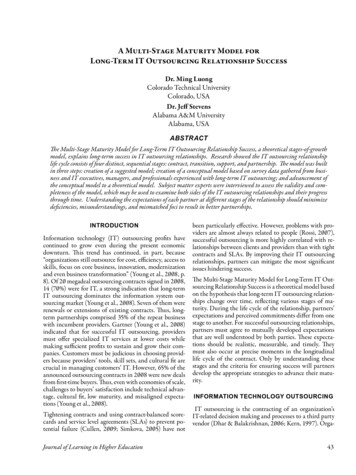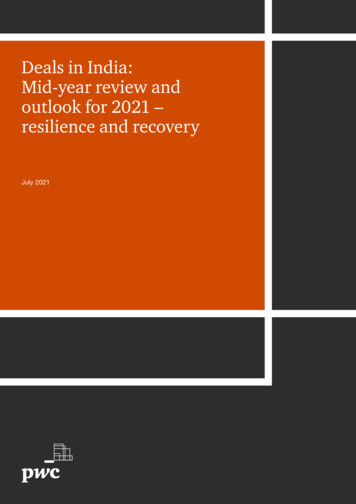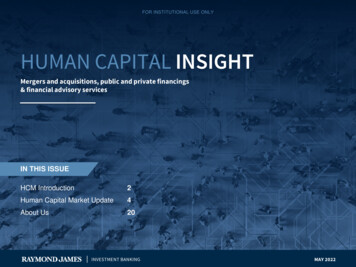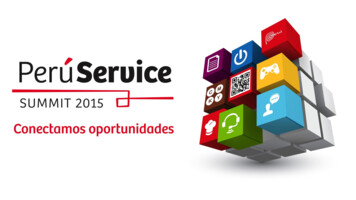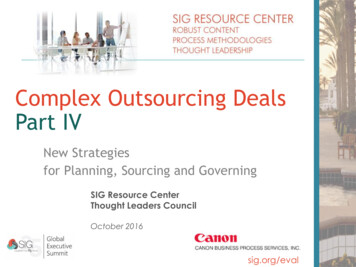
Transcription
Complex Outsourcing DealsPart IVNew Strategiesfor Planning, Sourcing and GoverningSIG Resource CenterThought Leaders CouncilOctober 2016sig.org/eval
SRC Thought Leaders CouncilMerrilee EvansDirector CategoryManagement, 6John FafianDirector, PwCjohn.j.fafian@us.pwc.com646.471.5755Bill HuberManaging 0124Troy KendrickBank of the bie ManosMcHenryChief Sourcing OfficerHuntington National 9Brad PetersonPartner & Attorney,Mayer Brownbpeterson@mayerbrown.com312.701.8568Brian SmithDirector, Global SupplyChain Services, Mascobrian smith@mascohq.com313.792.4280LindaTuck ChapmanCPO Emeritus &President, ONTALAlindatuckchapman@ontala.com416.452.4635Eric WalsworthSr. Manager, Total SupplierReliability, EYeric.walsworth@ey.com317.900-6098
AgendaThere’s a new breed of multi-sourced relationships, innovativesolutions and practices and emerging complexities that requirenew skills and expertise to harness.ObjectivesIntroduce best practices and real-life experiences that willinform your strategies and practices throughout the lifecycle ofthird party relationships during the three phases ofoutsourcing:1. Strategy and Planning2. Sourcing and ImplementationToday’s Focus3. Management and Governance
What we’ll talk about today The difference between management and governance andwhy it mattersBest practices in outsourcing management including teamstructure, roles and responsibilitiesEffective governance of complex deals and emergingtechnologiesLeveraging SIAM to manage complexity“Failing forward” - positive outcomes from issues andincidentsCase studies and lessons learned by our experts
Management, Governance:what’s the difference?Management(Operational)1. The “risk owner” in the “first line ofdefense”, the business leader, thesupplier/relationship owner, and theservice/engagement owner, managesWhatinputs and operational outcomes2. Are responsible for costs, operations,performance, contracts, issue andrelationship management andcommunicationGovernance(Oversight)we’ll1. The risk control experts in the “secondline of defense” are the 2nd Line ofDefense, with clear governanceaccountabilities2. They are responsible for the processes totalkassessaboutand todaycontrol risks within theparameters/tolerances set by seniormanagement3. Senior executive and the Board areultimately responsible for governance overstrategies, key decisions and impact ofthese complex relationships on the firmThe two are naturally complementary, asgood governance relies on good managementto deliver results in a transparent manner
Everyone has a job to doEach role and individual makes an important contribution tothe overall success of the relationship or relationshipsLifecycle Management and GovernanceSeniorExecutive &the BoardOperationalIntimacyScope &RequirementsStrategy /AssessmentStrategicPerspective ValidatePriorities Alignmentwith Goals RFP/SelectionBalanceEnterprise vs.Businessneeds OngoingManagementNegotiationAir Cover:Freedom toask & seeanswers RiskAppetite Escalationpoint for keyissues Respond toreporting RiskAppetiteFinance &Risk ControlFunctions Ensurerigor andlegitimacy Ensure rigorandlegitimacy RiskIdentificationandAssessment RiskControls nitExecutive Provideresources Collaborationvs.Entrepreneur OvercomeObstacles Strategic rtingRelationshipManager Get thedetails right Practicality ProvideExpertise Day to DayManagementProvideExpertise
Why it matters When developing operational strategies, then establishingand operationalizing complex outsourcing deals, clearlydefined roles and responsibilities ensure all the bases arecoveredSeparation of duties and authority between the business,risk control specialists, and senior management/the Boardensures that the firm’s best interests are kept in theforefrontRepeatable frameworks and tools developed by expertsincrease operational predictability and the probability ofsuccess can be leveraged, and learning sharedSenior leaders can make fact-based decisions in a soundmanner, ensure decisions are aligned with corporatepriorities, and respond quickly to changes in theenvironment and changing needs
SIAM – Leveraging a Service Integrator In complex multi-sourced relationships, using a serviceintegration management tool can reduce complexity andfocus on operational results
Avoiding common mistakes A mismatch between expectations and realityIneffective management of the relationshipFirst generation outsourcing relationships: often lack ofexperience and maturity get in the way of successFocus on overly detailed or irrelevant performance metrics:focus should be on core metrics that truly reflect businessprioritiesLow levels of openness, trust, and collaboration betweenpartnersInexperienced relationship managers can’t let go of old roleUnder-resourcing the retained team once transition iscompleteCompetence, appropriate resourcing andrealistic expectations enable successfuloutsourcing relationships
Some things to considerRight-sized controls environment: are proper checks andbalance in place to identify, mitigate and manage risks?Management and governance framework: delivers resultsagainst strategic and tactical goals, aligns day-to-daymanagement with senior level expectations for all partiesExecutive engagement: with strategic, corporate and P&Lresponsibility is a critical success factorStrong Vendor managers: do they have the right expertise tomanage operational outcomes, operations, execute andmanage actions coming from senior levels, and to deal withissues and opportunities?
Three Case Studies1. How bad can it get?2. How good can it be?3. Know when not to outsource
How Bad Can It Get?Major energy company outsourced all contact centeractivities to a near shore provider under a 10 year deal with30 pages of SLAs Issue: By year 8 things had fallen apart to such a degree thepartners were threatening each other with law suits Arbitration failed and a very acrimonious & expensive divorce ensuedWhy did a relationship that promised so much, deliver so little? Numerous and unforeseen technical challengesSupplier failed to grasp scope of business growth objectivesBusiness squeezed so hard the Supplier had no room to maneuverNit-picking, constant bickering over SLAs and focus on penaltiescompletely eroded service quality“What we have here is a failure to communicate!”
How Good Can It Be?Issue: HVAC Repair Service Company was having to replace fleet vans 2-3years earlier than expected as technicians overloaded them with toomany parts. Technicians focused on customer satisfaction: in winter inCanada, customers want their furnace repaired as quickly as possible.Solution: Outsourced to 3PL provider who redesigned the logisticsnetwork to provide parts staging stations across the Toronto region.Technicians picked up parts for that day’s calls in the morning,significantly reducing overweight vans.Why was this approach successful? Partners worked together to brainstorm an effective solution, includingtechnicians in the design discussions from the startFocus was on Customer Satisfaction, rather than fleet issuesPerformance evaluation was based upon two main criteria:1.2. Did the technician have all the parts needed when he got to a job?Number of Non-First Call resolution eventsContract identified year-over-year stretch goals, driven by technicians’ input
Know when not to outsource Engaged a strategic consulting firm to benchmark. Learnedoutsourcing less than peers. The company then engaged expertadvisors/counsel for an exhaustive assessment of what to outsourceover a 3-4 month period, including deep dives into processes, rolesand responsibilities, and risk assessment to: Identify scope for the RFP; create baseline targets/scope/rates RFP’s issued to top quartile firms and full day sessions were heldwith providers to refine requirements prior to final negotiations Engaged a law firm with deep expertise to work with the consultingfirm to create a contract/negotiate in parallel for BPO engagementThe Result: based on final business case, company did not outsourceany of the functions identified, but continue in a staff augmentationrelationship for selected offshore activities New rate cards: expansion of staff augmentation New contracts: a solid foundation for future BPO Top quartile contracts with incumbents (competitive process) Future opportunities: have the tools to conduct outsourcesuitability assessments
Failing ForwardLearning from failure
Failing forward“I have not failed. I’ve just found 10,000 ways thatwon’t work.” Thomas A. Edison“Success is stumbling from failure to failure with noloss of enthusiasm.” Winston Churchill“It's fine to celebrate success but it is moreimportant to heed the lessons of failure.” Bill Gates“ failure is where success likes to hide in plainsight.” Scott Adams
Turning failure into successFailure is a tremendous organizational learning experience Complex outsourcing revealed to be complexOptimism is tempered by experienceThe relationship and the contract both turn out to matterThe crisis forges a stronger, smarter teamOutsourcing issues get “top of the house” visibility and talentNow there is a story to tell when people ask “what could possibly gowrong?”And a career-enhancer You’re running into the burning building; numerous talented peoplehave skittered away Take credit for either regression to the mean or cleaning up the mess Even if it goes badly, you shine by fighting the good fight You’re the one with that “top of the house” visibility You’re going to learn a lot about how to build a stronger deal next time
Keys to successfully “failing forward” Collect and document facts Fail as fast as possible Festering problems tend to grow Acute problems generally resolve more easily than chronic problems Avoid the “why didn’t we know this earlier” problem Involve your lawyers early and often You can get the ordinary course terms out of the contract, but not thecommon law and statutory law that governs disputes Lawyers can help you see around the corners – they are trained in howbad situations get worse and how adversaries act The attorney-client privilege can shield for mistakes andmisperceptions You can easily make errors that are impossible to fix if you don’tinvolve the lawyers It’s their job to clean up these sorts of messes, making you look good
“WIFM” as a buyer and a provider?Good management, the right tools and strong governanceenables:1.Optimal, “right” outsourcing relationships2.Tighter alignment, integrated planning and joint work efforts3.Effective management of complexity, with appropriate oversight4.Predictable, optimized work efforts5.Flexibility, and the ability to anticipate and respond to changingneeds6.Prevention of avoidable risks, and an early warning system7.Ability to influence the future direction of 3rd party’s investmentdecisions8.Longer term relationships, growing together in a positive way
Additional ResourcesSIG Sourcing Resource Center
Additional resources available in the entAlsbridge6 Keys to Successin a Multi-SourcedEcosystem: RightSourcing 102AlsbridgeBest Practices inOutsourcing: The Procter& Gamble ExperienceThe University of St.Thomas IAOPMultisourcing ServiceIntegration New Roles,New Rules, New ResultsIntegris AppliedThe Right GovernanceFramework for Managingan Offshore ITOutsourcing RelationshipUniversity of Twente
SRC Thought Leaders CouncilMerrilee EvansDirector CategoryManagement, 6John FafianDirector, PwCjohn.j.fafian@us.pwc.com646.471.5755Bill HuberManaging 0124Troy KendrickBank of the bie ManosMcHenryChief Sourcing OfficerHuntington National 9Brad PetersonPartner & Attorney,Mayer Brownbpeterson@mayerbrown.com312.701.8568Brian SmithDirector, Global SupplyChain Services, Mascobrian smith@mascohq.com313.792.4280LindaTuck ChapmanCPO Emeritus &President, ONTALAlindatuckchapman@ontala.com416.452.4635Eric WalsworthSr. Manager, Total SupplierReliability, EYeric.walsworth@ey.com317.900-6098
Evaluation How-to:Why? Your feedback drivesSIG Event content By signing andsubmitting yourevaluation, you areautomatically enteredinto a prize drawingHow?Option 1: App1. Select Schedule2. Select Schedule by Day3. Select Day4. Select Session5. Scroll to Description6. Click on the Evaluation linkOption 2: Browser1. Go to www.sig.org/eval2. Select Session (#XX)COMPLETE &SUBMIT EVAL
RFP/ Selection Negotiation Ongoing Management Senior Executive & the Board Validate Priorities Alignment with Goals Risk Appetite Balance Enterprise vs. Business needs Air Cover: Freedom to ask & see answers Risk Appetite Escalation point for key issues Respond to reporting Finance & Risk Control Functions .
